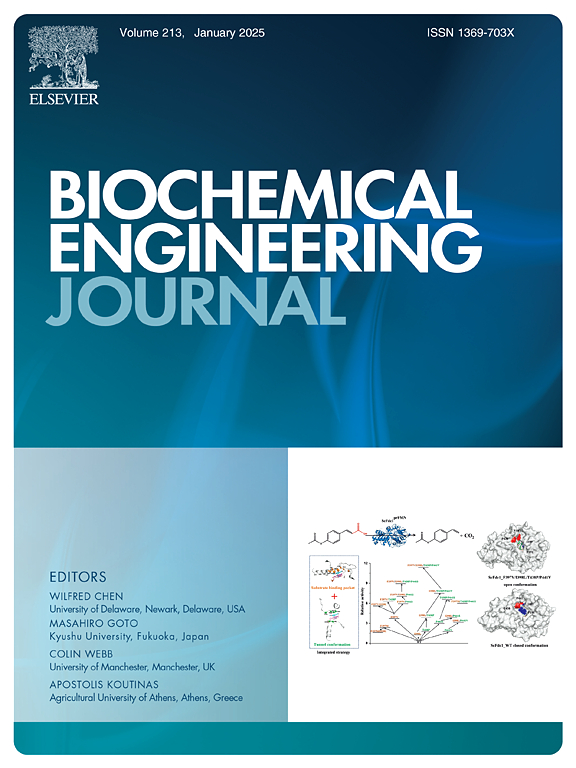Efficient degradation of sulfamonomethoxine in wastewater using a novel intimately coupled photocatalysis and biodegradation system prepared with the calcium alginate hydrogel
IF 3.7
3区 生物学
Q2 BIOTECHNOLOGY & APPLIED MICROBIOLOGY
引用次数: 0
Abstract
The insecure fixation of photocatalysts and their susceptibility to being covered by microorganisms existed in the traditional intimately coupled photocatalysis and biodegradation (ICPB) system. In this work, an ICPB system was developed by coupling g-C3N4 and biofilm carriers through introducing calcium alginate (CA) hydrogel. The ICPB-CA system showed superior removal efficiencies of sulfamonomethoxine (SMM) (99.3 %) compared to corresponding photocatalysis and biodegradation systems. Relatively higher stability was also achieved with SMM removal efficiencies higher than 92.5 % after three consecutive cycles, as CA hydrogel markedly improved the adhesion strength between the photocatalysts and biofilm carriers. Furthermore, SMM degradation pathways in the ICPB-CA system were proposed, with smaller-molecular products produced. Biotoxicity evaluation tests also indicated that the degradation products were less toxic than the parent SMM, suggesting that ICPB-CA system could significantly mitigate the antimicrobial activities of SMM. This study will provide a promising alternative to construct the ICPB system, realizing higher removal efficiency of antibiotics while decreasing their toxicity.
海藻酸钙水凝胶制备的新型光催化与生物降解密切耦合系统高效降解废水中的磺胺甲氧苄
传统的光催化与生物降解(ICPB)密切耦合系统存在光催化剂固定不稳定和易被微生物覆盖的问题。本研究通过引入海藻酸钙(CA)水凝胶,将g-C3N4与生物膜载体偶联,制备了ICPB体系。与相应的光催化和生物降解体系相比,ICPB-CA体系对磺胺甲氧嘧啶(SMM)的去除率为99.3 %。由于CA水凝胶明显提高了光催化剂与生物膜载体之间的粘附强度,连续三次循环后,SMM的去除率高于92.5 %,具有较高的稳定性。此外,还提出了SMM在ICPB-CA体系中的降解途径,并产生了小分子产物。生物毒性评价试验也表明,降解产物的毒性低于母体SMM,表明ICPB-CA体系可以显著降低SMM的抑菌活性。本研究将为构建ICPB系统提供一种有希望的替代方案,在降低抗生素毒性的同时实现更高的抗生素去除效率。
本文章由计算机程序翻译,如有差异,请以英文原文为准。
求助全文
约1分钟内获得全文
求助全文
来源期刊

Biochemical Engineering Journal
工程技术-工程:化工
CiteScore
7.10
自引率
5.10%
发文量
380
审稿时长
34 days
期刊介绍:
The Biochemical Engineering Journal aims to promote progress in the crucial chemical engineering aspects of the development of biological processes associated with everything from raw materials preparation to product recovery relevant to industries as diverse as medical/healthcare, industrial biotechnology, and environmental biotechnology.
The Journal welcomes full length original research papers, short communications, and review papers* in the following research fields:
Biocatalysis (enzyme or microbial) and biotransformations, including immobilized biocatalyst preparation and kinetics
Biosensors and Biodevices including biofabrication and novel fuel cell development
Bioseparations including scale-up and protein refolding/renaturation
Environmental Bioengineering including bioconversion, bioremediation, and microbial fuel cells
Bioreactor Systems including characterization, optimization and scale-up
Bioresources and Biorefinery Engineering including biomass conversion, biofuels, bioenergy, and optimization
Industrial Biotechnology including specialty chemicals, platform chemicals and neutraceuticals
Biomaterials and Tissue Engineering including bioartificial organs, cell encapsulation, and controlled release
Cell Culture Engineering (plant, animal or insect cells) including viral vectors, monoclonal antibodies, recombinant proteins, vaccines, and secondary metabolites
Cell Therapies and Stem Cells including pluripotent, mesenchymal and hematopoietic stem cells; immunotherapies; tissue-specific differentiation; and cryopreservation
Metabolic Engineering, Systems and Synthetic Biology including OMICS, bioinformatics, in silico biology, and metabolic flux analysis
Protein Engineering including enzyme engineering and directed evolution.
 求助内容:
求助内容: 应助结果提醒方式:
应助结果提醒方式:


